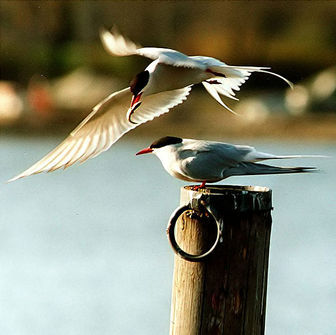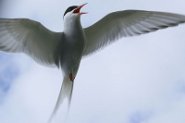Arctic Tern
Arctic Terns are medium-sized birds. They have a length of 33–39 cm and a wingspan of 76–85 cm . They are mainly grey and white plumaged, with a red beak and feet, white forehead, a black nape and crown , and white cheeks. The grey mantle is 305 mm, and the scapulars are fringed brown, some tipped white. The upper wing is grey with a white leading edge, and the collar is completely white, as is the rump. The deeply forked tail is whitish, with grey outer webs. The hindcrown to the ear-coverts is black.

Arctic Tern: a Frequent Flyer
 The Arctic Tern (Sterna paradisaea) is a seabird that can be found throughout the Arctic and the sub-Arctic areas of North America, Asia, and Europe. The species has quite the migration pattern, traveling all the way from the Arctic areas to the oceanic areas of Antarctica and back. This means that the bird travels 70,900 kilometers a year, or 44,300 miles. This is much larger than the migratory pattern of any other animal known to mankind.
The Arctic Tern (Sterna paradisaea) is a seabird that can be found throughout the Arctic and the sub-Arctic areas of North America, Asia, and Europe. The species has quite the migration pattern, traveling all the way from the Arctic areas to the oceanic areas of Antarctica and back. This means that the bird travels 70,900 kilometers a year, or 44,300 miles. This is much larger than the migratory pattern of any other animal known to mankind.
One interesting thing about the animal is the fact that it performs almost all of its tasks while in the air. Most of the time it is either flying or gliding. Some groups have a different mating cycle than others. The Arctic Tern nests every one to three years. It nests in the arctic, and once its nesting period comes to an end it once again flies south.
The Arctic Tern is about average in size in comparison with other birds. They are between 33 and 39 centimeters in length, which is 13 to 15 inches. Their wings span a distance of 76 to 85 centimeters, or 26 to 30 inches. For the most part, they have gray and white feathers, while their beaks and feet are a more colorful red. The neck and bottom of the bird are pure white, while the top is typically gray, and the top of the head is black.
They are also known to live very long. Many of them reach the age of thirty. Most of the foods that they eat are fish and various shellfish. The species is also quite populous, with about a million members. The overall population changes as a result of environmental impacts are not known, but there has been a decrease in the numbers of Arctic Terns found in the southern regions.
Arctic Terns are monogamous, mating for life. In most cases, an Arctic Tern will return to the same colony every year. The courtship ritual is quite strenuous, especially when it first occurs. It begins when a female will chase a male to a high altitude to test their agility. The male will then begin to find fish for the female. On the ground, the courtship ritual involves strutting with wings lowered and tail raised. The birds will then fly circles around one another. Once they have chosen each other, they then choose a nesting area. Both parents defend the nest.
Picture of the Arctic tern protecting nest near Markarfljot river in south Iceland, by OddurBen, licensed under Creative Commons Attribution-Share Alike 3.0 Unported license.
The Arctic Tern is classified as Least Concern. Does not qualify for a more at risk category. Widespread and abundant taxa are included in this category.

Family : Laridae
Genus : Sterna
Species : paradisaea
Authority : Pontoppidan, 1763

